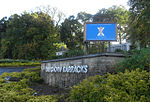Caerketton Hill

Caerketton Hill is a hill in the Pentland Hills range of Scotland. Standing at 478 m, it is at the northeast end of the approximately 25 km (16 mi) long chain of hills on the border between the council areas of Edinburgh and Midlothian. The nearest settlements are Currie, three miles to the west, and Loanhead, four miles to the east. Edinburgh's southern boroughs start about two kilometers north. The nearest hills are Allermuir Hill to the west and Woodhouselee Hill to the south. The Boghall Burn rises on the southern flank and eventually drains into the Firth of Forth via North Esk and Esk. The crest marks a 16-meter diameter and 1.5 meter high cairn. It was disturbed and is therefore no longer preserved in its original condition. The cairn is protected as a scheduled monument.
Excerpt from the Wikipedia article Caerketton Hill (License: CC BY-SA 3.0, Authors, Images).Caerketton Hill
Boghall Glen,
Geographical coordinates (GPS) Address Nearby Places Show on map
Geographical coordinates (GPS)
| Latitude | Longitude |
|---|---|
| N 55.881944444444 ° | E -3.2244444444444 ° |
Address
Boghall Glen
Boghall Glen
EH26 0PG
Scotland, United Kingdom
Open on Google Maps









